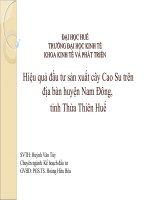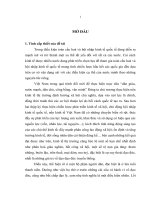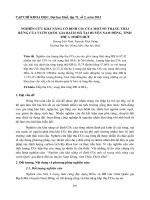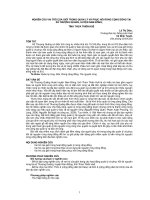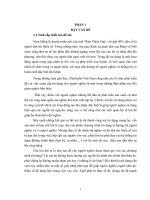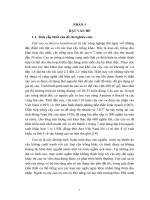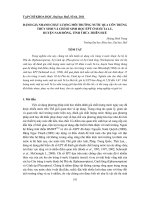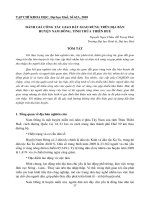Báo cáo nghiên cứu khoa học: "Thiếu máu ở trẻ em trường tiểu học của hai xã vùng cao huyện Nam Đông, tỉnh Thừa Thiên Huế" potx
Bạn đang xem bản rút gọn của tài liệu. Xem và tải ngay bản đầy đủ của tài liệu tại đây (73.33 KB, 10 trang )
449
JOURNAL OF SCIENCE, Hue University, N
0
61, 2010
ANEMIA IN PRIMARY SCHOOL-CHILDREN OF TWO HIGHLAND
COMMUNES IN NAM DONG DISTRICT, THUA THIEN HUE PROVINCE
Dang Thij Anh Thu, Hoang Trong Sy, Nguyen Van Hoa
College of Medicine and Pharmacy, Hue University
SUMMARY
A survey carried out in 2007 of 336 highland school children in Nam Dong district,
Thua Thien Hue Province showed that the total rate of anemia was 28.9%, in which it was
almost all at mild level (26.2%) and moderate level (2.7%), there were no cases at the serious
level; The malnutrition rate of children was 39%. According to the stool tests, the rate of
children getting hookworm was the highest with 18.2%. There was a significant difference
between anemia and ethnic groups (the anemia rate of the Kinh children was lower than that of
the Catu ones). Moreover, there were other significant differences between anemia and
biological factors, including: age, nutritional status, and hookworm infection. Factors relating
to anemia were geography, household economic levels, the number of days eating meat and fish
a week, having parents working as farmers, educational levels of mothers and mother’s practice
in feeding children.
1. Introduction
In recent decades, although there has been a considerable change of socio-
economic conditions, anemia is still an important health issue in many rural and
highland areas in Vietnam. Particularly for school-age children, it is dangerous, and not
only related to their physical and mental health but also affects the long-term
development of the community. Thuong Nhat commune and Khe Tre town are two poor
highland areas of Nam Dong district. Basically, people in both areas have a low
education level, poor income, traditional customs and habits, topography and so on,
which restricts living environment, hygienic conditions, and children’s health. Therefore,
objectives of this study are to Determine the rate of anemia of primary school children
in Thuong Nhat commune and Khe Tre Town of Nam Dong district, Thua Thien Hue
province, compare this rate of the Katu ethnic group to the Kinh and Find out the
relationships between anemia and some factors on this group.
450
2. Methodology
2.1. Participants
The study was conducted in primary schools of Thuong Nhat commune and Khe
Tre town of Nam Dong district, Thua Thien Hue province. 336 pupils randomly selected
by EPI INFO statistical software were evaluated, included 164 pupils of Thuong Nhat
commune primary school and 172 Khe Tre Town primary pupils. The study was
conducted from June to September, 2007.
2.2. Research method
This was a cross-sectional survey.
Children’s weight and height was measured to examine the nutritional condition.
Blood samples were collected for the measurement of hemoglobin concentration,
using the KX-21 machine (Symex, Japan).
Formalin ether technique was used to test stool samples to look for helminthes
eggs.
Mothers of those children were directly interviewed for more information
relating to anemia, the answers were written down using questionnaires.
Assessment indicators
- Evaluating children’s anemia status based on the hemoglobin concentration
standard (g/dl) of the World Health Organization (Mild anemia: 9.0-11.9g/dl, moderate
anemia: 7-8.9g/dl, serious anemia: lower than 7g/dl).
- Evaluating helminthes infection status by whether children had helminthes
eggs (including Hookworm’s, Ascaris’or Trichuris’s eggs) in stool samples or not.
- Weight and height were used for evaluating nutrition condition of children (If
the children are younger than 9 years old, the index of weights over heights based on the
conferential population was calculated:
- Lower than -2SD was considered malnutrition
- Equal to or over -2SD was considered normal
For 9 year old children and the older, whose height was over the upper
boundary’s height, a BMI indicator was applied.
BMI =
Weight
Height
2
Assessment: under 5
th
centigrade of the conferential population was considered
malnutrition, equal and over 5
th
centigrade of conferential population was considered
451
normal.
- Some other factors were also evaluated, including: children’s infectious status
as well as blood lost status in the six weeks before the study was conducted, household
economic levels, the number of days eating meat and fish a week, having parents
working as farmers, educational levels of mothers and mother’s practices regarding
feeding children.
Statistical analysis
All data were coded and entered into EPI INFO version 6.04b and SPSS 15.0 for
analysis.
3. Results and discussion
3.1. The social- demographic characteristics of the sample
Table 3.1. The social- demographic characteristics of participants.
Characteristics n % p
Ethnic
Kinh 220 65.5
p>0.05
Catu 116 34.5
Sex
Males 186 55.4
p>0.05
Females 150 44.6
Demography
Khe Tre 172 51.2
p>0.05
Thuong Nhat 164 48.8
Ages
6 45 13.4
p>0.05
7 52 15.5
8 49 14.6
9 43 12.8
10 64 19.0
>10 83 24.7
Total 336 100
There was no significant difference between the two ethnic groups, number of
males and females, number of people living in Thuong Nhat commune and Khe Tre
town, as well as in ages of participants ( p>0.05).
452
Table 3.2. Anemia rate, malnutrition rate and helminthes infection rate of participants.
Characteristics n %
Anemia
Moderate 9 2.7
Mild 88 26.2
Normal 239 71.1
Nutritional status
Malnutrition 131 39.0
Normal 205 61.0
Helminthes infection
Hookworm 61 18.2
Ascaris 14 4.2
Trichuris 5 1.5
The total anemia rate of primary school children in Thuong Nhat commune and
Khe Tre town in 2007 was 28.9%. All cases were at mild and moderate levels. There
was no serious anemia. This result was similar to the ones of Cao Ba Loi ‘s study and
Youssef A. ‘s survey (in which, the anemia total rate of primary school children in Lang
Son City and Morocco were 29.4% and 31.6%, respectively). Also, it was acceptable
according to the rate given by the WHO, the anemia rate of children from 5 to 12 years
old is around 37%.
The rate of malnutrition was 39.0%. In the stool samples, the rate of samples
having Hookworm ‘s eggs were highest (18.2%). The stool samples containing other
worm ‘s eggs were low. This might result from nation collective helminthes worming
program for primary school children which are carrying out in Nam Dong district.
3.2. Some factors linking to anemia’s status
3.2.1. Biological factors
Table 3.3. Relationships between anemic status and sex, ethnic, age of studied group
Characteristics Total
Anemia
2
, p
n %
Sex
Male 186 61 32.8
2
= 3.13
p > 0.05
Female 150 36 24.0
Ethnic
groups
Catu 116 47 40.5
2
= 11.71
p < 0.01
Kinh 220 50 22.7
Age (years) 6 45 22 48.9
2
= 23.20
453
7 52 21 40.4 p < 0.01
8 49 14 28.6
9 43 14 32.6
10 64 15 23.4
>10 83 11 13.3
Total 336 97 28.9
The results showed that there was a significant difference in anemia status
between males and females in the studied group. Yet, there were significant links
between the anemia status and ethnic groups (the rate of anemia in the Katu children
was higher than that of the Kinh children, p<0.01), and ages (the younger had the higher
anemia’s rate, p<0.05).
Compared with the study of Cao Ba Loi et al., the results also pointed out that
there was a significant difference in the number of anemic males and anemic females in
the studied group, and the relationship between the anemia status and ethnic groups
(the Kinh children and other minority children (Tay, Nung,…) was found.
Table 3.4. Relationships between anemia ‘s status and nutrition’s status,
common helminthes infections.
Characteristics Total
Anemia
2
, p
n %
Nutrition’s status
Malnutrition 131 46 35.1
2
= 4.08
p < 0.05
Normal 205 51 24.9
Common helminthes
infection
Yes 89 31 34.8
2
= 2.09
p > 0.05
No 247 66 26.7
Hookworm infection
Yes 61 25 41.0
2
= 5.33
p < 0.05
No 275 72 26.2
Ascaris infection
Yes 14 5 35.7
2
= 0.08
p > 0.05
No 322 92 28.6
Trichuris infection
Yes 5 3 60.0
2
= 1.10
p > 0.05
No 331 94 28.4
Total 336 97 28.9
454
A significant difference between anemia and children’s nutritional status was
found in this study (p>0.05). According to many other surveys, there was a high anemia
rate in malnourished children (over 80%). Anemia and malnutrition have a strong link
with each other, the more seriously malnourished children get, the worse their anemia is.
Evaluating the relationships between helminthes infection and anemia showed
that there was a link between Hookworm infection and anemia. The research of Ta Thi
Tinh also reported that there was no connection between anemia and Ascaris infection
as well as Trichuris infection, but a significant relationship between anemia and
Hookworm infection was found.
Table 3.5. Relationships between Anemia and infectious or blood lost status in 6 months before
the study was conducted.
Characteristics Total
Anemia
2
, p
N %
Blood lost status
Yes 9 4 44.4
2
= 0.45
p > 0.05
No 327 93 28.4
Infectious status
Yes 26 10 38.5
2
= 1.26
p > 0.05
No 310 87 28.1
Sum 336 97 28.9
Although there was no relationship between anemia’s status and blood lost status
as well as infectious status in the six months before the study was conducted, chronic
infection and bleeding are factors relating to anemia. Therefore, children with chronic
infections or who have serious bleeding have had chronic bleeding in the past need to be
looked after carefully. It is necessary for them to supplement their iron levels with
tablest to prevent anemia.
3.2.2. Environmental factors
Table 3.6. Relationships between anemia status and demography,
household economic levels and the number of days eating meat and fish a week
Characteristics Total
Anemia
2
, p
n %
Demography
Thuong Nhat 164 65 39.6
2
= 18.08
p < 0.01
Khe Tre 172 32 18.6
Household
economic levels
Under the
average
193 73 37.8
2
= 17.66
455
Equal or over the
average
143 24 16.8
p < 0.01
Number of days
eating meat and
fish a week
0 - 3 days 163 67 41.1
2
= 23.08
p < 0.01
4 - 7 days 173 30 17.3
Total 336 97 28.9
Demography is one of the factors relating to anemia in our study. According to
the results in the survey of Nguyen Cong Khanh on the anemia status of Vietnamese
children in 1987, there was a significant difference in the rate of anemic children
between rural areas and urban areas; that was also similar to the results of the study of
Adewuji JO (1992).
There was a considerable link between household economic levels and anemia
status. It is reasonable that economic factors influence many other elements, including
children nutrition status. The research of Ali, on the relationship between demographic-
social factors and anemia status in 2001 found the difference between household
economic levels and anemia’s status.
The children who ate more meat and fish a week have lower rate of anemia.
Compared with results of the study of Nguyen PH, it also reported that there was a
relationship between anemia status and the number of days children ate fish and meat a
week. Additionally, the survey of Nguyen Chi Tam mentioned that the low frequency of
fish and meat intake was a risk factor of anemia among members in family, including
the adult.
Table 3.7. Relationships between anemia‘s status and having parents working as farmers
Characteristics Total
Anemia
2
, p
n %
Mother’s
occupation
Farmer 203 76 37.4
2
= 18.29
p < 0.01
Other 133 21 15.8
Total 336 97 28.9
Father ‘s
occupation
Farmer 205 75 36.6
2
= 16.36
p < 0.01
Other 126 20 15.9
Total 331 95 28.7
There was a relationship between anemia status and parents who were farmers.
The possible reason is that if parents work as farmers their children have more
occasions to play in the fields, combined with other factors such as habits of walking
456
barefoot and so on, leading to good conditions for hookworm infection. Therefore, it
can cause anemia.
Table 3.8. Relationships between anemia‘s status and educational levels of mothers and
mother’s practice in feeding children
Characteristics Total
Anemia
2
, p
n %
Educational levels of
mothers
Illiterature 135 51 37.8
2
= 8.75
p < 0.05
Primary
school
129 29 22.5
Higher than
primary
schools
72 17 23.6
Mother’s practice in
feeding children
No 204 70 34.3
2
= 7.50
p < 0.01
Yes 132 27 20.5
Total 336 97 28.9
Generally, the results showed that the higher the educational levels of mothers,
the lower anemia rate found in their children. According to the results of a study of Cao
Duc Hanh on the anemia status of children from six months to under 15 years old, there
was also a link between anemia ‘s status and educational levels of mothers, some other
research had a similar conclusion. In addition, the connection between anemia status
and the mother’s practices of feeding children was found by our study.
4. Conclusions
The total anemia rate of primary school children in Thuong Nhat commune and
Khe Tre town was 28.9%, all of them were at the mild level (26.2%) and moderate level
(2.7%), there were no serious cases of anemia. The rate of malnutrition was 39.0%. In
the stool samples, the rate of samples having hookworm‘s eggs were highest (18.2%).
There was a significant difference between anemia rate of different ethnical
groups. The rate of anemia in the Katu children was higher than that of the Kinh.
Moreover, biological factors relating to anemia were ages, nutritional status,
hookworm infection.
Environmental factors which have a relationship with anemia status included
demography, household economic levels, the number of days eating meat and fish a
week, parents working as farmers, educational levels of mothers and the mother’s
practice in feeding children.
457
5. Recommendations
Katu children in Nam Dong should supplement their diet with iron tablets and
cured for normal reasons of anemia.
Suitable solutions should be given to improve malnutrition and hookworm
infections among these primary school children.
The knowledge of mothers and awareness about anemia should be strengthened.
Further research needs to be conducted in Nam Dong about anemia to get the
correct assessment and detect its relating factors for improving community health.
REFERENCES
1. Wilson JD , Braunwald E, Isselbacher KJ. Principles of internal medicine. vol.1. Ha
Noi: Medical Publishing House 1999:466-471.
2. Loi Cao Ba et al. Relationships between anemia with intestinal parasitic infection in
school children (6-14 years old) in Quang Lac, Mai Pha, Chi Lang communes of Lang
Son city, Lang Son province. Malarial and Parasitic diseases preventive Magazine 2005,
vol.1: 77-82.
3. Nguyen Chi Tam. Nutritional anemia and some relating factors in 11 to 14 year old
children in a rural commune [Master ‘s thesis of community nutrition], Hanoi Medical
University 1996.
4. Ta Thi Tinh et al. The relationship between anemia‘s status of primary school children
and worm infection in a highland commune of Thanh Hoa Province. Studies reported at
National Conference in Malaria – Parasitology – Insects in 2001-2005, Ha noi Medical
Publishing House 2006:126-133.
5. Quizhpe E. et al., Prevalence of Anaemia in Schoolchildren in the Amazon Area of
Ecuador. Rev Panam Salud Publica 2003; 13(6):355-361.
6. Nguyen PH et al. Risk Factors for Anemia in Vietnam. Southeast Asian J Trop Med
Public Health 2006; 37(6):1213-1223.
7. Nguyen Cong Khanh et al. Anemia in Vietnamese Children in 1987. 20 years of
Prevention and Control of Micronutrient Deficiencies in Vietnam. Hanoi Medical
Publishing House 2001:102-103.
8. Nguyen Thi Ngoc Phuong et al. Effects of Anemia on Physical and Behavioral-mental
Development of Children in Budang District Binh Phuoc Province in 2000. 20 years of
Prevention and Control of Micronutrient Deficiencies in Vietnam. Hanoi Medical
Publishing House 2001:146-162.
458
9. World health Organization. School-age Children. Helminthes Control in School-age
Children. Genever: World Health Organization Press 2002:9-10.
10. Youssef A. et al. Prévalence de L’ Anémie Chez les Préadolescents Scolaires dans La
Province de Kénitra au Maroc. Cahiers Santé 2004 ;14 :37-42.

